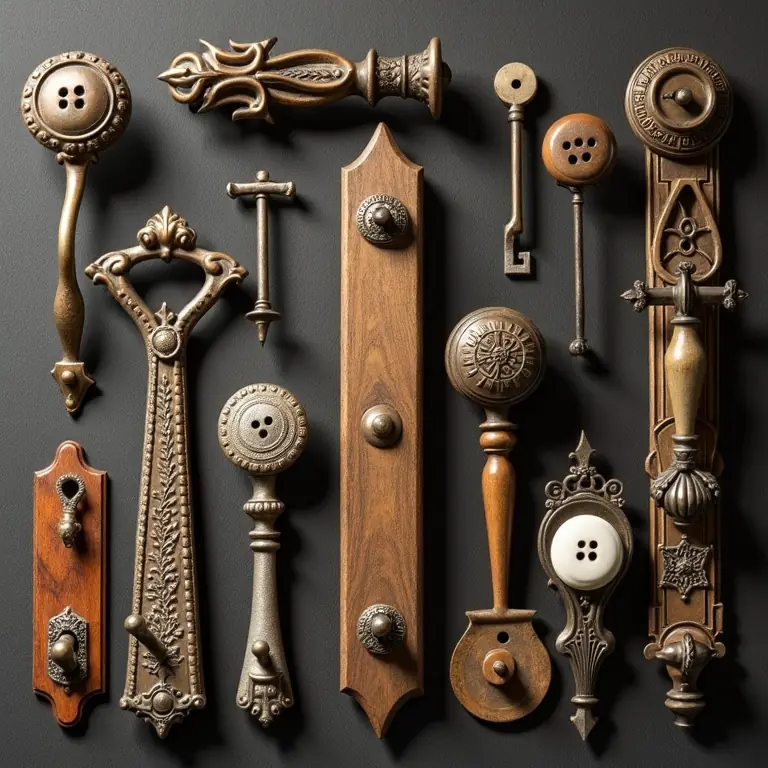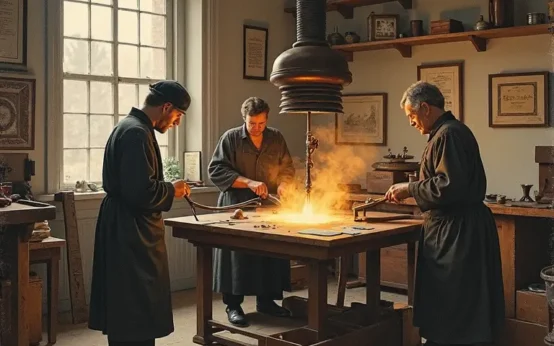Buttonhooks. The very name conjures images of Victorian ladies meticulously fastening their high-button shoes, or perhaps a dapper gentleman completing his ensemble. But beyond this somewhat narrow perception, lies a surprisingly consistent science, a fascinating interplay of materials science, mechanical engineering, fashion, and social history. These small, often elegant tools weren’t merely accessories; they were essential components of a changing world, reflecting advancements in manufacturing, evolving fashion trends, and the daily lives of people from the 18th to the early 20th centuries. This article delves into the surprisingly consistent scientific principles behind buttonhooks, exploring their design, materials, function, and the reasons for their eventual decline.
A History Rooted in Function: From Necessity to Fashion
Before the widespread adoption of buttons as we know them today, fastening clothing was a far more complex affair. Lacing, tying, and broaching were common, but often time-consuming and requiring considerable dexterity. The development of functional buttons, while appearing as early as ancient times, didn’t become truly widespread until the 17th and 18th centuries, and even then, they weren’t the easy-to-fasten buttons we see today. Early buttons were often decorative rather than practical, requiring intricate fastenings. The real shift came with the development of smaller, more robust buttons – and the corresponding need for a tool to manage them.
Initially, buttonhooks weren’t solely for footwear. They were used on clothing as well, particularly for garments with closely spaced, small buttons. As fashion evolved in the 19th century, particularly with the rise of high-button boots and shoes, the buttonhook became inextricably linked with footwear. The Victorian era, especially, saw a surge in their popularity, becoming almost *de rigueur* for anyone wearing buttoned boots or shoes.
The Science of the Hook: Materials and Mechanics
The seemingly simple design of a buttonhook belies a surprisingly sophisticated understanding of materials and mechanics. The fundamental principle is leverage. A buttonhook extends the user’s reach and provides a mechanical advantage, allowing them to manipulate small buttons with greater ease and precision. But the choice of materials played a crucial role in the effectiveness and durability of these tools.
Material Selection: A Spectrum of Choices
Buttonhooks were crafted from a diverse range of materials, each offering distinct advantages and drawbacks. The most common materials included:
- Steel: The most prevalent material, particularly for the hook itself. Steel offered excellent strength and could be hardened to maintain its shape and resist wear. Different steel alloys were used, with higher carbon content generally resulting in a harder, more durable hook.
- Iron: Often used for earlier examples and less expensive buttonhooks. Iron is softer than steel and more prone to rust, but it was readily available and affordable.
- Silver: Often used for handles, particularly for higher-end buttonhooks. Silver provided an aesthetic appeal and was perceived as a status symbol. However, silver is a relatively soft metal and prone to wear.
- Mother-of-Pearl: A popular choice for handles, prized for its iridescent beauty. Mother-of-pearl is organic and relatively fragile, requiring careful craftsmanship.
- Bone and Ivory: Also used for handles, offering a smooth, tactile feel. Like mother-of-pearl, these materials were susceptible to damage.
- Horn: A more durable and affordable alternative to bone or ivory, often used for handles.
- Bakelite & Celluloid: With the advent of plastics in the late 19th and early 20th centuries, these materials began to appear in buttonhook handles, offering a wider range of colors and designs.
The Hook’s Geometry: Optimizing Leverage
The shape of the hook itself was not arbitrary. The angle of the curve, the length of the shaft, and the diameter of the hook’s opening were all carefully considered to maximize leverage and minimize strain on the user. A steeper curve provided greater leverage but could also be more difficult to maneuver. A longer shaft offered more reach but could reduce precision. The ideal geometry depended on the size and placement of the buttons being fastened.
The tip of the hook was often slightly flattened or sharpened to facilitate slipping under the button. The degree of sharpness varied; some hooks were designed for delicate fabrics and had a rounded tip, while others were more aggressive for tougher materials. The consistent goal was to engage the button without damaging the surrounding fabric.
Beyond the Basics: Decorative Elements and Specialized Designs
While functionality was paramount, buttonhooks were often embellished with decorative elements, reflecting the prevailing artistic styles of the time. Handles were frequently engraved with floral motifs, geometric patterns, or monograms. The materials themselves – mother-of-pearl, silver, and intricately carved bone – contributed to the aesthetic appeal.
Furthermore, specialized buttonhooks were developed for specific purposes. For instance, longer, more slender hooks were designed for high-button boots, while shorter, sturdier hooks were used for heavier fabrics. Shoe-shaped buttonhooks were a novelty, often given as gifts. Some buttonhooks incorporated additional features, such as a small brush for cleaning shoes or a nail nick for minor repairs. The range of designs demonstrates a nuanced understanding of user needs and a desire to cater to individual preferences.
The Science of Materials: Durability and Degradation
The longevity of a buttonhook depended heavily on the materials used and the environment in which it was stored. Steel hooks, if properly maintained, could last for generations. However, rust was a constant threat, particularly in humid climates. Regular cleaning and oiling were essential to prevent corrosion. Silver handles tarnished over time, requiring polishing to restore their luster. Organic materials, such as mother-of-pearl and bone, were susceptible to cracking, chipping, and discoloration. Plastics like Bakelite proved more durable but could become brittle with age.

The degradation of buttonhook materials provides valuable insights into the properties of these materials themselves. The rate of corrosion in steel, the susceptibility of silver to tarnishing, and the fragility of organic materials all reflect fundamental chemical and physical processes. Studying the condition of antique buttonhooks can help us understand how these materials behave over time and how to best preserve them.
The Buttonhook in Context: Social History and Gender Roles
The widespread use of buttonhooks, particularly among women, offers a glimpse into the social norms of the Victorian era. The high-button boot, a symbol of fashion and status, required the use of a buttonhook for fastening. This seemingly simple act reinforced gender roles, as women were often expected to rely on these tools to maintain their appearance. The buttonhook became associated with femininity and domesticity, and mastering its use was considered a mark of refinement.
However, the buttonhook also represented a degree of constraint. The process of fastening high-button boots was time-consuming and required considerable effort. This physical labor underscored the limitations imposed on women’s mobility and independence. The eventual decline of the buttonhook, coinciding with the rise of more convenient fastening methods, can be seen as a symbol of changing social attitudes and greater freedom for women.
The Decline and Legacy: A Tool Rendered Obsolete
The reign of the buttonhook began to wane in the early 20th century with the advent of new fastening technologies. Zippers, Velcro, and improved button designs gradually replaced the need for these tools. Boots and shoes with fewer buttons, or with buttons positioned for easier fastening, became more common. By the 1930s, the buttonhook had largely disappeared from everyday use, relegated to the realm of antiques and collectibles.
Despite its obsolescence, the buttonhook left a lasting legacy. It serves as a tangible reminder of a bygone era, a testament to the ingenuity and craftsmanship of past generations. It also provides a fascinating case study in the interplay of technology, fashion, and social change. The scientific principles underlying its design – leverage, materials science, and ergonomics – remain relevant today, informing the development of new tools and technologies.
Furthermore, the study of buttonhooks allows us to appreciate the often-overlooked details of everyday life in the past. These small, seemingly insignificant objects offer a window into the habits, customs, and values of people who lived centuries ago. Like the study of antique barometers and their scientific underpinnings, or the design of historical candle snuffers, examining buttonhooks reveals a surprising level of sophistication and attention to detail.
Collecting and Preserving Buttonhooks: A Hobby with Historical Depth
Today, buttonhooks are popular collectibles, attracting enthusiasts who appreciate their historical significance and aesthetic appeal. Collectors often specialize in specific types of buttonhooks, such as those made from silver, mother-of-pearl, or with unusual designs. The value of a buttonhook depends on its age, materials, condition, and rarity.
Preserving buttonhooks requires careful attention to their materials. Steel hooks should be cleaned and oiled regularly to prevent rust. Silver handles should be polished gently to remove tarnish. Organic materials should be stored in a stable environment to prevent cracking or discoloration. Proper preservation ensures that these fascinating artifacts will continue to be enjoyed by future generations.
Conclusion: More Than Just a Tool
The buttonhook is far more than just a tool for fastening boots. It’s a microcosm of history, a reflection of technological innovation, fashion trends, social norms, and the enduring human desire for both functionality and beauty. The consistent scientific principles that guided its design, the careful selection of materials, and the attention to detail in its craftsmanship all speak to a level of ingenuity that is often underestimated. By understanding the science behind the buttonhook, we gain a deeper appreciation for the complexities of the past and the enduring legacy of seemingly simple objects. The story of the buttonhook, like the evolution of vintage sewing machine mechanisms, illustrates how even the most mundane aspects of daily life are shaped by scientific principles and historical forces. And, much like understanding historical recipe measurements, understanding the nuances of buttonhook design reveals a surprisingly consistent approach to problem-solving across time. Finally, the attention to detail and miniature scale involved in their creation shares similarities with the crafting of historical toy soldiers.


 The Curious Acoustics of Historical Echo Chambers: Resonance, Ritual, and Revelation
The Curious Acoustics of Historical Echo Chambers: Resonance, Ritual, and Revelation  The Curious Cartography of Scent: Mapping Perfume Ingredients Through History
The Curious Cartography of Scent: Mapping Perfume Ingredients Through History  The Curious Lexicon of Lost Trades
The Curious Lexicon of Lost Trades  The Surprisingly Consistent Science of Historical Ice Harvesting – A Frozen History of Commerce & Preservation
The Surprisingly Consistent Science of Historical Ice Harvesting – A Frozen History of Commerce & Preservation  The Surprisingly Consistent Science of Historical Toy Soldiers – Miniature Warfare, Materials & Collective Play
The Surprisingly Consistent Science of Historical Toy Soldiers – Miniature Warfare, Materials & Collective Play  The Surprisingly Consistent Etymology of Place Names – Uncovering Stories in Street & Town Origins
The Surprisingly Consistent Etymology of Place Names – Uncovering Stories in Street & Town Origins